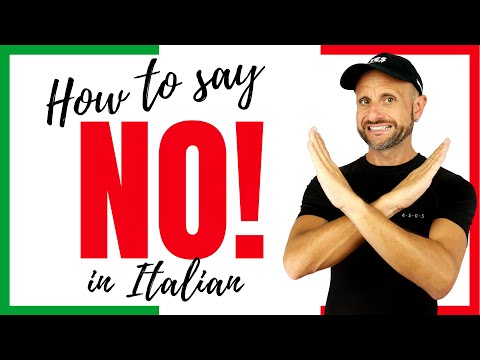Different Ways to Say no in Italian
Even in Italian, it can be difficult to say no at times, after learning how to say yes, you can learn how to say no in Italian.
As mentioned, to say no in Italian, simply say “no, grazie” (no, thank you) to answer negatively but respectfully.
But there are also various Italian alternatives. Let’s see how to use Italian phrases like non penso/non credo, macché, or neanche per sogno!
Common ways to say no in Italian
Non penso/ Non credo
These two Italian expressions are mostly used to show doubts or concern about a condition or what could happen.
For example:
Sai se il supermercato è ancora aperto? Non penso/Non credo.
Do you know if the supermarket is still open? – I don’t think so/I don’t believe so.
Mi sa di no
Use “mi sa di no” when you’re not sure about the answer, but you think it will be a negative one.
Example:
Sai se Claudia è andata a comprare il latte? Mi sa di no!
Do you know if Claudia went to buy milk? No, I don’t believe so!
Ne dubito (proprio)
When you wish to express doubt or the sensation that something is about to happen or did not happen in Italian, you can use one of these expressions.
Example:
Pensi che Marco uscirà di nuovo con noi dopo quello che è successo? Ne dubito (proprio).
Do you think Marco will go out with us again after what happened? – I (really) doubt it!
Non è possibile
Use this phrase if you want to express surprise, sorrow, or disappointment for anything that happened to you or someone else.
For example,
Hai saputo che Michele ieri si è licenziato? Non è possibile! Seriamente?
Did you know that Michele yesterday quit his job? No way! Seriously?
Temo di no
Use “Temo di no” if you want to express regret for something you’re not responsible for.
Example:
Hai ricevuto l’invito per il matrimonio di Sara? Temo di no!
Did you receive the invitation to Sara’s wedding? I’m afraid not!
Magari
This Italian phrase is commonly used when you want to express hope or a wish for something that will or will not happen.
Example:
Andrai in vacanza quest’estate? Magari! Ma non ho un soldo!
Will you go on Holiday this summer? I wish! But I don’t have any money!
How to say no in Italian: formal expressions
La ringrazio, ma devo rifiutare
This quite respectful phrase can be used to address someone you don’t know well and who is likely older than you.
In this scenario, you’re expressing gratitude for what they’re offering you, but you’re “forced” to decline the offer due to unique circumstances.
Example:
Le andrebbe di giocare a scacchi? La ringrazio ma devo rifiutare. Sono in ritardo.
Would you like to play chess? Thank you, but I must say no. I’m late.
Sarà per la prossima volta
To avoid looking impolite, you can use good manners to decline whatever they are offering you, postponing it until the next time you see each other.
For example:
Ti andrebbe di cenare insieme? Oggi non riesco, sarà per la prossima volta.
Would you like to have dinner together? I can’t help today. Maybe next time.
Grazie, come se avessi accettato
This is an extremely polite way to say no in Italian when you want to decline something offered to you by someone you hardly know.
For example:
Prende un caffè? Grazie, come se avessi accettato!
Would you like a coffee? Thanks, pretend I have accepted!
How to say no in Italian: informal expressions
Macché
One of the most well-known Italian idioms for saying no, you can use it to express a deep sense of frustration.
Hai finito di studiare Italiano? Macché! Ho appena cominciato!
Have you finished studying Italian? As if! I just started!
Non ci penso proprio
In this case, your goal is to point out that you aren’t considering what they told you to do.
For example:
Ti va di andare a fare shopping domani? Non ci penso proprio!
Would you like to go shopping tomorrow? Don’t even think about it!
Neanche per sogno/ Neanche per idea
Also, in this case, you can use one of these two phrases to say no in Italian when you are absolutely convinced not to complete something you were suggested to do.
Example:
Potresti andare tu a fare la spesa al posto mio? Neanche per idea!/Neanche per sogno!
Could you go grocery shopping instead of me? Not a chance!/In your dreams!
Scordatelo
This Italian way of saying no may sound harsh because it implies that you would never consider the idea of helping someone with something without even thinking about it.
For example:
Puoi aiutarmi con i compiti di Italiano? Scordatelo!
Can you help me with my Italian homework? Forget it!
When ”No” means ”Yes” in Italian
Come no
This is a very popular Italian expression that is used when you need to confirm something definitively.
Nonostante tutto, sono riusciti a finire in tempo, vero? Come no!
Despite everything, they were able to finish on time, right? For sure!
Question Tags
Question tags are generally associated with English grammar, but they can be translated into the Italian language in a variety of ways, one of which is by adding the word “no” followed by a question mark to the conclusion of your statement.
Il dottore dovrebbe arrivare a momenti, no?
The doctor should arrive soon, right?

Learning Polite Ways to Say No
As you can see, there are many different ways to say no in Italian.
Some are rather common in daily conversation, while others are more uncommon or restricted to a small context of use.
Furthermore, keep in mind that certain phrases should be used carefully because they can be misunderstood (like, “Scordatelo!” and “Neanche per idea!“).
So, remember to pay attention to how and when using them!










One Response
Wow, this is so helpful! Grazie mille for sharing these different ways to say no in Italian. I’m definitely going to practice them!